Furniture Styles

Design creates culture. Culture shapes values. Values determine the future
When you're buying solid wood furniture that's going to last for the rest of your life and then some, one of the biggest considerations is the design of the pieces. Popular design philosophies come and go- what's popular one decade might not be the next. But there are certain design philosophies that have stood the test of time. Designs that never go out of style, and that can be displayed proudly for generations.
Some of our most popular styles of furniture design are listed below, ranging from traditional styles like shaker and mission, to modern styles like art deco and mid century, as well as contemporary designs that push the boundaries of the past and help to mold the future.
Shaker

Shaker style furniture is characterized by clean lines, tapered legs, and minimalist designs. Its known for being practical and simple down to the very last detail. Originally designed in the late 1700s by followers of the religious group the Shaking Quakers, shaker furniture has become a staple in interior design known for being timeless and elegant.
Simplicity carried to an extreme becomes elegance.
Mission

Mission style furniture is characterized by rectangular shapes, 90 degree angles, and straight vertical and horizontal lines. First conceived in the Arts & Crafts period at the turn of the 19th century, mission and craftsman style furniture has maintained popularity in traditional and arts & crafts design circles ever since.
Art Deco

Art Deco furniture is characterized by its muted colors, shiny metal accents, eccentric shapes, and polished finishes. This style originated in France in the 1920s and then spread to the US and Europe in the early 1930s. Art Deco style can still be found integrated into contemporary furniture and design today, often as an accent piece or to create a focal point.
Mid Century Modern

Mid-Century Modern furniture is characterized by its clean lines, gentle curves, and organic shapes. This style originated mid-20th centuryhence its name but thanks to its elegant simplicity and timeless aesthetic, Mid-Century Modern furniture is still highly popular in contemporary interior design.
Contemporary

The term "contemporary" refers to the designs of the here and now. The designs that push the boundaries of what we think is possible, that challenge the status quo, and that define the future of design.



















